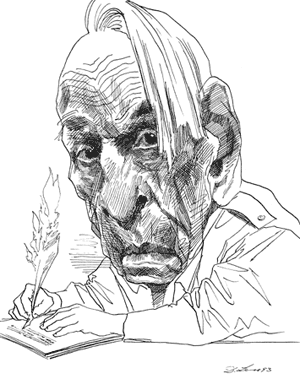The crucial event of Norman Maclean’s last book (he died in 1990) was a forest fire in the rugged western mountains of Montana. The fire took place in August of 1949; Maclean, who was then and had been for years a member of the department of English at the University of Chicago, was not actually present at the blaze, but he had ample reason to be concerned with it. Many years earlier, between other jobs and intervals of an academic career, he had spent a couple of summers with the Forest Service; he knew the district well, and still maintained a summer cabin at Sealey Lake some miles away. He had a technical interest in the form of forest fires and their often erratic behavior. He was of course in no condition to man a fire line, but his impulse to understand this major tragedy of the deep woods was insatiable.
In some respects the fire at Mann Gulch was not particularly remarkable. It was started by a lightning strike at the top of a ridge, and burned down the hollow box of Mann Gulch, where at different points it might have been stopped by a shift in the winds, or simply by running into the Missouri River. But why for some fifteen minutes of that furiously hot summer afternoon did it suddenly switch direction, pull itself together as it were, and explode up the steep hillside, leaving behind it the bodies of thirteen fire fighters?
The fatal fifteen minutes that made this fire special both historically and humanly involved a work gang of only fifteen volunteers, semimilitary in organization but under civilian control. They called themselves, and were known as, the smokejumpers, and they had very little training for their jobs, which required in fact not much technical skill but a high measure of personal bravery. They were asked simply to jump from an airplane by parachute as close as possible to the center of a forest fire and there try to put it out. They had a foreman or leader, whom for the most part they obeyed, but they knew they might face situations where all they could do was drop their tools and run like hell. From the superannuated C-47 they crammed themselves into to their specially adapted ground axes (Pulaskis), their equipment was mostly secondhand or improvised. Some of the smokejumpers were years short of meeting the age requirement, and these boys were by no means the least daring and effective of them. Since they usually jumped in the late afternoon, the average fire, which they counted on having under control by next morning, was known as a “ten-o-clocker.” In their first foolish overconfidence, they were sure that Mann Gulch was just another ten-o-clocker.
The flight from Missoula to the boiling clouds of Mann Gulch was uncomfortable but not particularly dangerous. The pilot, a skilled and experienced man, skimmed the hilltops as closely as he dared, but the fury of the gusting winds kept him above the threatening peaks. From that safer altitude he made his series of cargo drops, and on the whole successfully. But supplies that were scattered from an extra altitude had to be painfully collected, and the radio that was to keep the ground party in touch shattered on impact. From the first the omens were not good.
The terrain on which the smokejumpers landed was, as they knew it would be, rough, almost vertical, the shale surface capable of supporting only bunches of mountain pine and fir with areas of mountain grass in between. The wind, blustering and erratic, made the direction of the fire’s movement wholly unpredictable. Pitch-pines exploded under the fierce heat, scattering mini-fires like hand grenades; grass fires swallowed up acres of meadow in a single flare.
Having begun atop the draw known as Mann Gulch, the fire was burning steadily but with frequent flareups downhill. To keep it from spreading, the crew began hiking down the gulch toward the Missouri River. But the fire, taking advantage of perverse wind gusts, leaped from one side of the gulch to the other, and began burning uphill as in a chimney. When the fire from above joined with the two tongues of flame from below, they literally exploded in a storm of fire. The smokejumpers could not possibly escape, and turned and ran; their bodies lay on the hillside where they fell until they were marked by white concrete crosses. These crosses are very closely grouped. Some got farther than others before the flames caught them, but not much farther.
Two men made their escape by climbing up to a ledge of rock at the top of the gulch and working their way through a crevice. The main body of thirteen perished within a few seconds, suffocated in the smoke or hideously scorched in the flames. The foreman survived by a stratagom at once brilliantly improvised and traditional—very much the subject of controversy, in any case.
Advertisement
As the flames came roaring up the gulch toward him, the foreman deliberately started another fire, a counterfire, at the base of the rock ledge; and as his men came racing past, seeking desperately to get to the top of the ridge, he called on them to stay with him. Then he lay down in the ashes, getting his face as close to the oxygen in the ground as possible. The counter-fire was by no means a radical innovation. It has been described as a common practice of the Plains Indians, and appears as an artful device of a wily scout in a novel by James Fenimore Cooper. But on the raging hillside of Mann Gulch it was an absolute novelty and a real, literal, lifesaver. Unhappily, it saved only one life; and among the relatives of those who died, there were some who claimed that the counterfire actually killed some of the smokejumpers, and prevented others from escaping. There were lawsuits and resentments for years to come. Some matters men simply could not bear to talk about, and when Maclean tried to look into some relevant government files, he found considerable portions of them closed off from him.
With the benefit of hindsight, controversy could only multiply. The training of the firefighters was little better than skimpy; the foreman, it turned out, had had a chance to meet personally only three of the men for whose lives he would be responsible. As a unit, the gang had little chance to work together. At best, the study of how forest fires behave was in its infancy. Large fires were not much studied because there were few of them and because close students had a rather appalling mortality rate. But the nation was horrified by the Mann Gulch holocaust; there were many reports and studies, so that after 1949 there were no, or at least very few, fatalities in the smokejumper corps. One of the conclusions that gradually emerged was that not every fire had to be fought to the death. What, after all, did it matter if every last patch of mountain grass in western Montana lived out its destined days? The great Yellowstone fire of 1988 was an ecological and aesthetic loss, no doubt, but if it had been fought by the old rules, the loss of human life would have been atrocious.
Investigating every circumstance of the Mann Gulch fire became an obsession for Norman Maclean; he returned again and again to walk over the ravaged hillside, accumulating relics and taking photographs as he went. He looked up the two survivors of the work party and went with them over the ground itself. He worked through dusty archives, finding, for example, the charred and battered wristwatch of one of the young smokejumpers, with its hands melted together at just four minutes to six. He burrowed into the theories of wind currents, and investigated the newly developing science of fire explosions. Inevitably the scientific burrowings and scrapings remain, in one detail or another, incomplete. But Maclean’s second book was a humane and personal memoir, scarcely less elegiac and elegantly written than the first one, A River Runs Through It. That story has recently been converted, under the same title, to a very good movie; and the movie and the two books offer some special points of comparison.
A River Runs Through It (published in 1976 and eloquently reviewed in these pages by Roger Sale* ) is an autobiographical novella. Set in Missoula, Montana, where the father of the family was a Presbyterian minister, the story centers on the art of fishing for trout with wispy flies, and on the tormented relation between the two sons, Norman and Paul. From the first, Norman—staid though not stuffy—is recognized as a potential professor of literature; Paul is a village roughneck destined for a brutal early death; he is also a smalltown newspaperman, and a fly-fisher of genius. Yet this relatively short and simple story can be given very different emphases. One can’t, for example, overlook the fact that the movie, for reasons of its own, makes explicit, not to say emphatic, note of the six years he spent as a student at Dartmouth College that Norman Maclean, writing in his own person, neglects to mention.
These were evidently important years, not only in developing Maclean’s literary gift, but also possibly in turning Paul toward the smalltown hoodlumism that resulted in his early and violent death. There were of course practical reasons for these decisions. The salary of a provincial Presbyterian preacher would certainly not suffice for two Ivy League tuitions. If Norman went to college, Paul by inexorable logic had to stay home. So why did the two brothers turn out so differently? Why did the younger brother, so full of life and imaginative vitality, “go bad”? Norman loved Paul but could never reach him, never understand him. The block between them could only have been Norman himself.
Advertisement
Purists will no doubt deplore the liberties that Robert Redford has taken with Norman Maclean’s story; but the fatalistic impulses driving Paul are crucial to the narrative, and they clearly bothered Norman Maclean both as narrator and as a character in the story. Seeking worldly advice, Norman consults the avuncular police sergeant of Missoula, and from him gets the somewhat perfunctory explanation of Paul as a “black Scot” on the loose analogy of various “black Irishmen” whom the sergeant has known. There is an unemphasized irony in the situation of a Presbyterian minister’s son seeking enlightenment from an Irish policeman; and the “explanation” does not in any case amount to much. It comes to no more than saying Paul was surly and quarrelsome because that was his nature, and that picture accords not at all with the dashing young fisherman aglow with his prowess—as was the Paul Maclean whom we had previously got to know.
Since the major dramatic contrasts of the story depend on the character and development of Paul in contrast with Norman, the reader may well be surprised at the caution with which Norman approaches the relation between the brothers. Both books in a sense follow the same theme—they mourn the death of a young man or men unknown: they are sorrowful, masculine, beautiful. The two books of Norman Maclean make up in their laconic austerity a dark American idyll of which the language can be proud. Whether one wants a psychological explanation of the family history doesn’t alter the classic outlines of this provincial north woods tragedy.
This Issue
January 28, 1993
-
*
The New York Review, May 27, 1976, p. 24. ↩




